Migration, Identity and Sovereignty
1/77
Earn XP
Description and Tags
A level Edexcel- Topic 8b
Name | Mastery | Learn | Test | Matching | Spaced |
|---|
No study sessions yet.
78 Terms
Globalisation has caused extremely significant changes in the global economic system, changing the pattern of demand for labour; this has encouraged both rural-urban migration within countries ( China) and international migration between countries ( EU-Schengen)
What is globalisation?
What has globalisation led to?
Globalisation is a process enabling financial and investment markets to operate internationally, largely as a result of deregulation and improved communications
The growing economic interdependence of countries worldwide through increasing volume and variety of cross-border transactions in goods and services, freer international capital flows and more widespread diffusion of technology.
Globalisation has led to an increase in internal and international migration
2014- more than 230 million people live in a country they were not born in
The world is becoming increasingly interconnected due to increased trade and cultural exchange. Interdependence is increasing due to the sharing and movement of services, goods and people.
Modern transport networks facilitate increased migration
Migration is not an inevitable consequence of globalisation- the vast rise in trade has coincided with a decline in migration between India and the UK.
A lot of international migration is regionalised e.g. USA and Mexico and Poland and Germany
Changes in the pattern of demand for labour at a national scale are often linked with globalisation
What is the core-periphery system?
Give an example of one
How do they occur/change over time?
What are backwash effects?
the uneven spatial distribution of national population and wealth between two or more regions of a country, resulting from flows of migrants, trade and investment.
National core-periphery systems will develop and strengthen over time on account of positive feedback effects.
e.g. Brazil, with the 'golden triangle' at its core and the Amazon as its main peripheral area.
Uneven economic growth may be linked originally to a natural advantage that one core region enjoys over others e.g. resources via raw materials or a coastline
The core-periphery model explains regional inequalities by suggesting that core regions accumulate economic wealth and resources, while periphery regions experience a lack of investment and development. The model highlights how economic activities and opportunities tend to be concentrated in core regions, leading to uneven distribution of wealth, income, and development indicators between the two.
Overtime, an initial imbalance can become exaggerated due to the perpetual outflow of migrants, resources and investment from peripheral regions> these flows together are called backwash effects!
Backwash- flows of people, investment and resources directed from peripheral to core regions. This process is responsible for the polarisation of regional prosperity between regions within the same country.
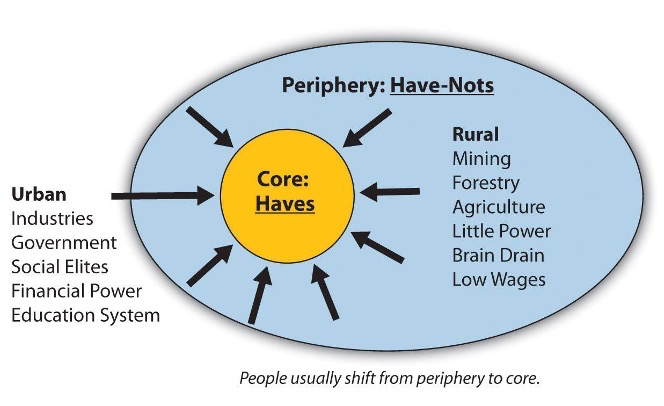
How do global systems encourage rural-urban migration? +examples of China and Spain
within countries:
introduction of mechanised agriculture and land grabs by states and agribusinesses- push
pull factors: linked with global supply chain growth in export processing zones.
China:
Rural Henan province had the biggest exodus of 10.25 million (bigger than the entire Swedish pop)
Urban Guangdong province received 20.5 million migrants (bigger than the Romanian pop)
1978- 20% of pop lived in cities
As of 2022, approximately 65% of people in China live in cities.
This gave cities a site factor as there was a larger, moderately priced labour force, and FDI increased
authorisation of free movement allowed China to benefit from globalisation
Estimates suggest that by 2025, a further 350 million people will have moved to China’s cities
Barrier: The hukou system- 1950s- new communist gov introduced restrictions on internal migration- everyone was registered at a particular household- permits to move were expensive and mainly aimed for the highly educated and mainly men- as a system it is not longer working due to China being the global hub of manufacturing.
Many of the reforms purport to abolish hukou differences by eliminating certain hukou categories. They do not completely abolish the hukou system, however. Migrants must still meet locally-set criteria in order to transfer their hukou registration to a given urban area.
Spain:
The Celtiberian Highlands in a rural region of east madrid has been all but abandoned. It has a population of 503,566 inhabitants
Only 8 people per square metre
The province of Soria has 600 villages with fewer than 100 people and an average age of 57, as young people leave to seek opportunity in Madrid and Barcelona (global hubs)
Spain has a low birth rate - 1.16 births per woman (2022), meaning that rural recovery is unlikely (a tipping point has been reached when local schools shut and people move away)

Example of core-periphery polarisation at a larger spatial scale
EU- Schengen Area
Free movement of labour has helped an international core-periphery pattern to develop
core region used to include the world cities of London, Paris, Brussels and Berlin where labour migration flows from eastern and southern Europe are directed.
Most border controls were removed in 1995 with the establishment of the Schengen Area, which enables easier movement of people and goods
The UK kept its border controls
EU labour can move to where it is most in demand, though this comes at the cost of fears of terrorism and uncontrolled refugee movements.
enabled passport free movement-

Which EU states have the biggest populations of people born in other EU states? and why? give 3
Luxembourg- nearly half of the population 47% non-nationals. It is a hub for cross-border workers and professionals
Malta- 25% of population- position as a financial and digital services centre.
Austria 19%- many EU citizens- central location in Europe and strong economy
Evaluate the Schengen Agreement (pros and cons)
Pros of the Schengen Agreement | Cons of the Schengen Agreement |
- The creation of a single external border allows for a single set of rules for policing the border. - Police have the right to cross borders to chase criminals, allows for a stronger and more efficient police force, perhaps ensuring safety of both countries. - Joint efforts across countries e.g. to fight drug related crime. - Police can share databases of wanted or undesirable people and stolen objects. - The Schengen visa gives non-EU nationals easy access to most of Europe | - Increased crime risk due to easy border crossings between countries, can allow criminal to escape and travel and larger distance going unstopped. - Criticised by Eurosceptics saying that it is an open door for migrants and criminals. - 13 November Paris attacks alarmed how easy it was to cross borders due to the Shenzhen agreement. |
What is an SEZ?
A special economic zone is an industrial area, often near a coastline, where favourable conditions are created to attract foreign TNCs and FDI- including low tax rates, exemption from tariffs and export duties, huge pools of cheap labour, and lower environmental standards.
They act as a window to the outside world in terms of commerce, trade and globalisation- that wealth will radiate out to the rest of the country.
What is the spatial division of labour?
The distribution of different stages of economic activity across space, leading to the specialisation of work within particular places at a range of scales
What is a migrant?
People who move from one location (a source area) to a new location (a host/destination area) permanently.
How has globalisation changed the global economic system since 1980?
What is the global shift?
Global shift - Outsourcing of manufacturing jobs by the developed world's TNCs to lower cost locations (such as China).
The movement of jobs from developed countries (such as the Uk and USA) to new locations in emerging economies such as China and Mexico.
The global shift has created new locations of economic growth and job creation and job losses elsewhere. Economic changes have driven migration changes as demand for labour has changed.
Impact on migration - Mass internal rural-urban migration from the countryside to China's cities
Key words: define!
Voluntary migration
economic migrant
refugee/asylum seeker
international migration
internal migration
migrant has a choice or not whether to migrate
a person who migrates to improve their quality of life
a person who has fled armed conflict and who needs international protection (asylum seekers have sought asylum but it might not have been granted yet)
migration between different countries
migration within a particular country
Between 3–4% of the global population live outside their country of birth but this proportion varies greatly between countries because of different policies relating to international migration and levels of engagement with the global economy
As of 2014, 230 million people lived in a country that wasn’t their place of birth (approx. 3-4% of the global population). .
This percentage has not changed much because of the global population increasing
1990s- international migration directed towards developed world destinations like New York and Paris since then world cities in developing countries have had more influxes e.g. Mumbai and Lagos
There is a lot of variation within individual nations
This may be due to different levels of political engagement with the global economy- if a state has not adopted liberal immigration rules, then it is less likely to be integrated into global systems, and also, this will affect how much influence TNCS can have in a nation.
2013- US has the largest number of international migrants 45 million.
There were 47.8 million immigrants residing in the United States as of 2023
( Singapore or Japan or Australia).
What is the policy? | Impact of the policy? | Why do they have this policy? | Advantages of the policy | Disadvantages of the policy |
dual approach aimed at managing population growth, avoiding demographic challenges and supporting economic development.
It has liberal migration rules
population can be divided in 2- permanent citizens who are residents and temporary immigrants/workers as non-residents.
singapore encourages skilled professionals, entrepreneurs and investors to apply for permanent residency.
migrant workers are offered work permits but they have very strict rules.
companies must adhere to sector-specific limits on the proportion of foreign workers to locals.
Singapore selectively grants citizenship to PRs based on economic contribution, family ties, and social integration. This policy prioritises maintaining the country’s social and cultural fabric while addressing demographic needs.
great ethnic diversity
4th largest financial centre in the world
lots of international schools
A lot of businesses locate their Asia-Pacific head offices there
Gov policy maintains that unskilled and low-skilled migrants remain a transient workforce subject to repatriation in periods of economic downturn.
Singapore wants to maintain its aggressive economic growth and their rank as 3rd in education
addresses demographic challenges
The pattern of international migration is changing and will continue to change because environmental, economic and political events affect both the source areas of many migrants and their destinations; this results in flows of economic migrants, refugees and asylum seekers. (1)
Most migrants move for work or to re-join family members; there are other significant causes, including displacement of refugees due to conflict and poverty in their regions of origin ( migrants crossing the Mediterranean). (2)
see A3 sheet
What are some social causes of migration?
Family – follow workers abroad
Extended family then move – diaspora growth- especially with economic migrants
Post-colonial migration
International students- within recent years, there has been a large increase in the volume of young people migrating to study elsewhere
What are some environmental causes of migration?
People specifically relocating due to tectonic disasters, natural events or Climate Change impacts
What are some political causes of migration?
Conflict, war, persecution- Refugees, asylum seekers
International displacement of millions in 2015
Also displaced internally
E.g. 70,000 Rohingya Muslims fled persecution in Buddhist-majority Rakhine state in Myanmar
Many became stranded on smugglers’ boats
What are some economic causes of migration?
Generally the poorest don’t migrate
Up to £5000 to move from Africa to Europe
Poorest don’t have access to this capital
Voluntary economic migration- people moving to improve their wealth and quality of life.
Causes for Mediterranean migration?
Arab Spring
Outbreak of Libya’s civil war
Syrian crisis
Economic change
Syria Case Study
2011 - Outbreak of the Syrian civil war. Inspired by the "Arab Spring" uprisings, confrontation between the government and opposition soon develops into a multi-sided fight involving Islamists and rebels that draws in world powers. Some 600,000 people are estimated to have died.
2024 - President Asad is toppled after a swift rebel offensive led by Hayat Tahrir al-Sham (HTS) captures the capital Damascus.
is it stable enough for migrants to return
Theories of migration
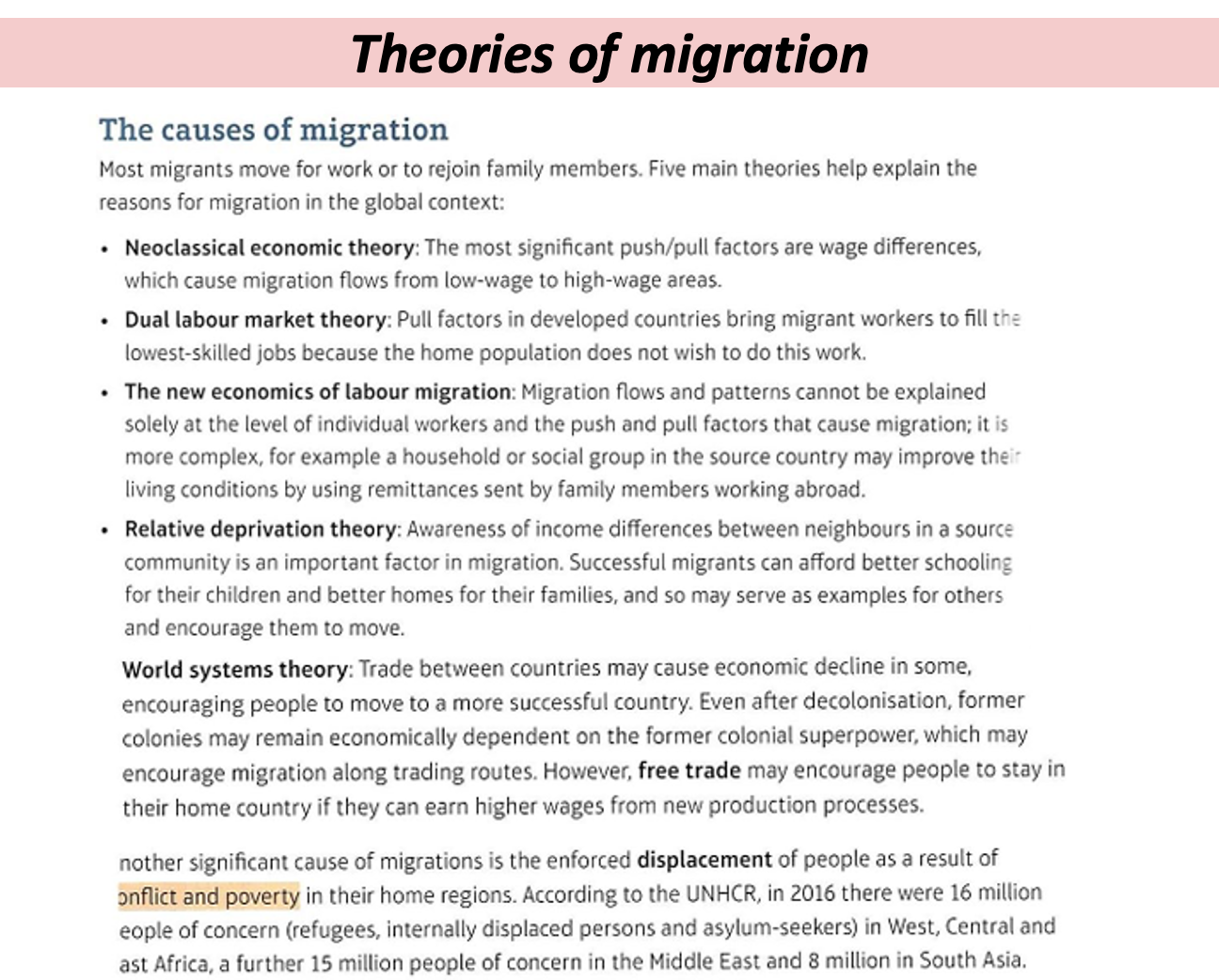
Lee’s model of migration
Obstacles of migration:
•physical barriers
•Immigration laws/ policies
•Lack of capital
•Travel costs
•Illiteracy/ education
•Military service
•Language
•Family pressures
•Role of gender? (e.g. Qatar’s pop pyramid)
•Age (which sector of a population is most likely to migrate and why?)
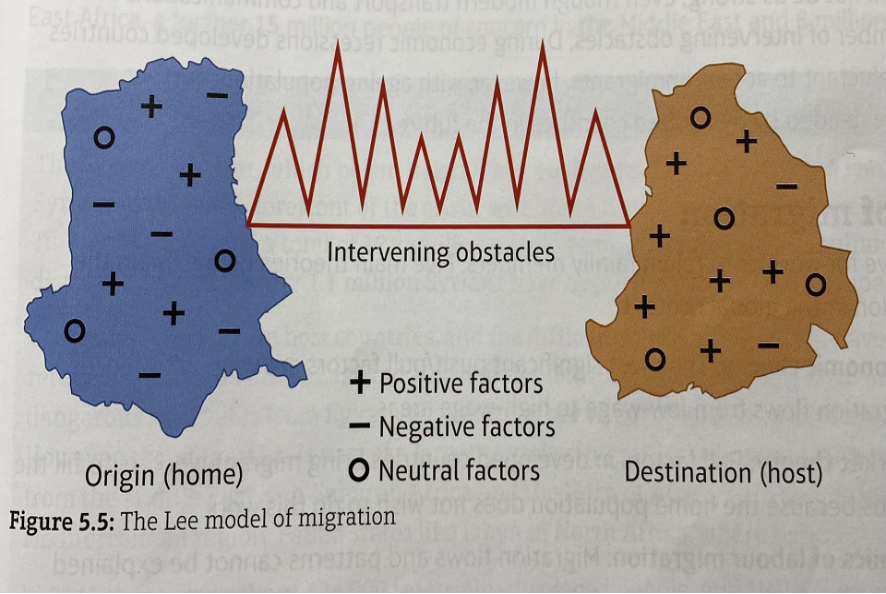
which countries are targeted?
Germany
Sweden
Belgium
UK
Define diaspora growth
a dispersed group of people with shared cultural background who have spread internationally from their homeland
Benefits of Mediterranean migration
Immigrants give Italy 500 million euros a year in taxes more than they take in services
migrants are reviving ghost towns in Italy- young residents emigrated for urban areas paved with gold but young migrant populations fill their vocational and livelihood gaps and therefore bolster economic growth
Problems of Mediterranean migration
Smugglers
Human trafficking
unregulated sea crossings- only check when deaths and drowning has occured
Mediterranean Migration crisis in numbers
By the end of 2015, an unprecedented number of migrants had arrived to the EU – 1,015,078 – having taken perilous journeys across the Mediterranean Sea to Europe in search of safety. The news dominated European political debate and media. More than 800,000 people were trafficked by sea from Turkey to Greece. There were 4,000 recorded deaths as people drowned in overloaded and unseaworthy boats.
Why the Mediterranean?
gateway between two continents
route towards europe
many developed countries
What range of factors informed migrants' decisions to leave their homes?
How were these journeys experienced by migrants - what routes were taken before arriving into Europe?
Why did migrants move on from countries to which they initially travelled?
What sorts of actors are involved in smuggling?
What is the difference between the categories of migrant and refugees and are these categorisations helpful?
How did international governments co-operate to support migrants and refugees?
Source destinations for asylum seekers reaching Italy and Greece by boat 2009-2015
To what extent is globalisation responsible for Mediterranean migration?
Case study: Migration from Bangladesh due to climate change
Case study: Poland to the UK
Case study: Migration from Myanmar (the rohingya crisis)
Economic theory migration
• Migrant labour mostly focused on movement to core regions
• Economic theory views humans as an economic resource
• Business needs humans to make use of – need to be able to move to where work is available (optimisation of the UK)
• Migration can be an effective tool to make sure economic output is optimised (hence why free movement can be a good thing!)
• However, this can increase spatial disparities
• There are arguments that backwash effects are balanced by spread effects (trickle down) in the remittances that are sent away from the core
backwash effects- lots of focus on the core, flows of people, investment and resources directed from peripheral to core regions. This is responsible for the polarisation of regional prosperity between regions within a country.
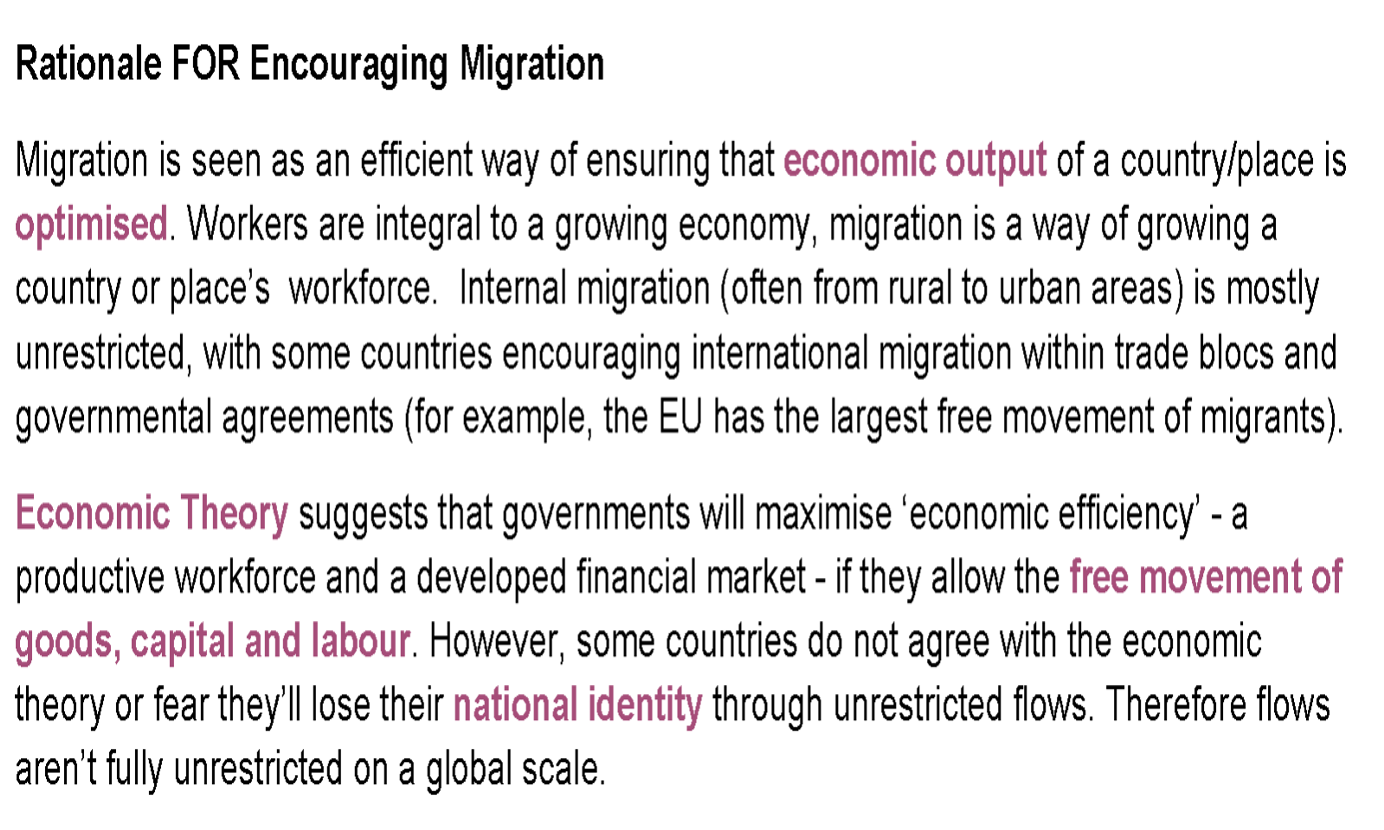
Rationale for and against migration
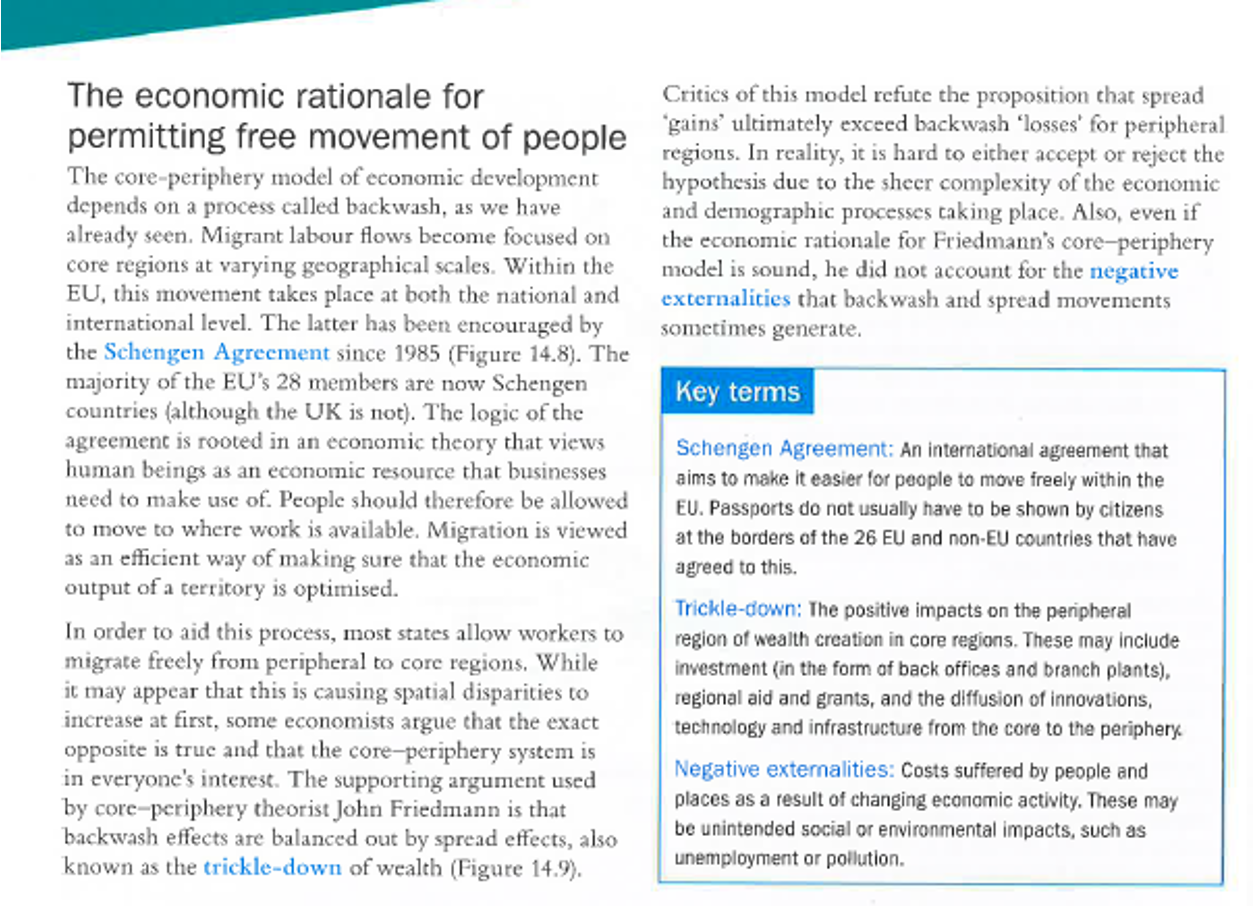
Economic theory suggests that economic efficiency is maximised when goods (free trade), capital (deregulated financial markets) and labour (open-borders) can move freely across international borders but this poses serious challenges for national identity and sovereignty.
Friedman’s backwash model - London offices moving outwards to secondary cores- people have to commute
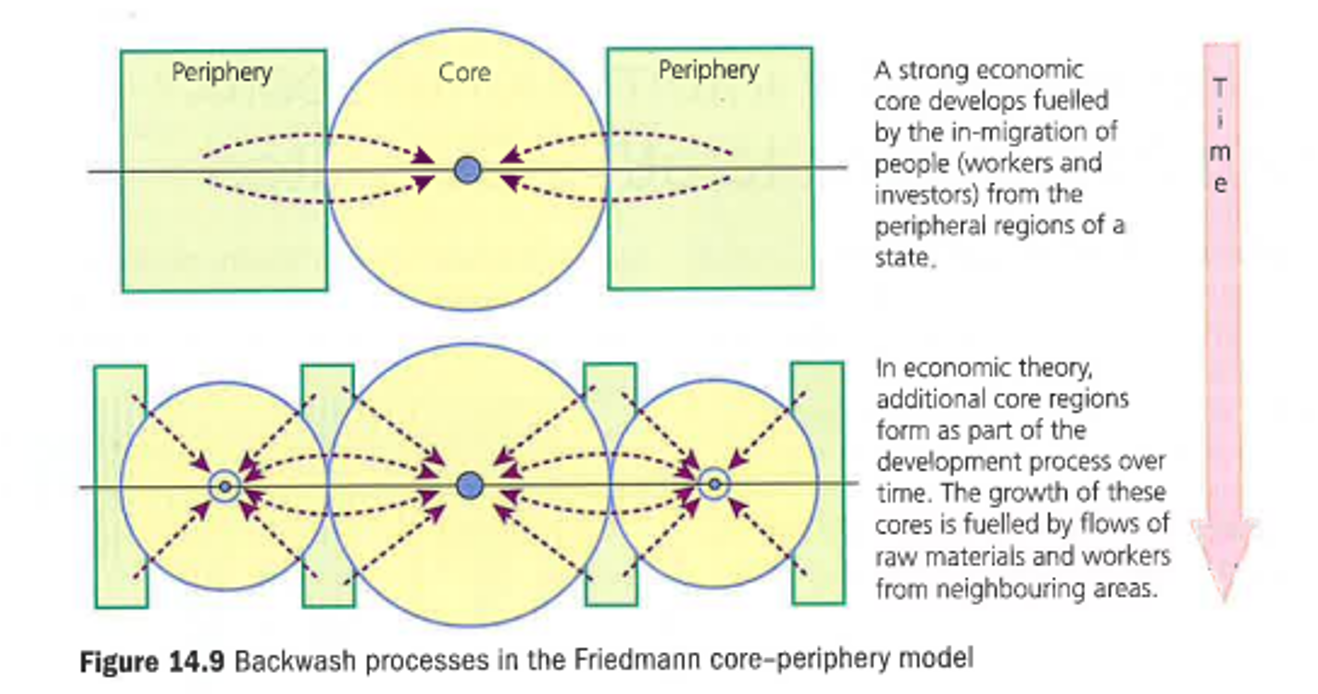
The movement of labour is unrestricted within many nation states to ensure efficient allocation of resources ( regional movements in the UK) and the same logic applies for some global regions (EU) but does not yet apply at a global level.
Refugee crisis
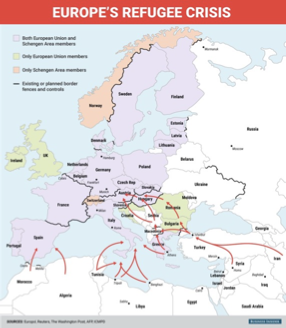
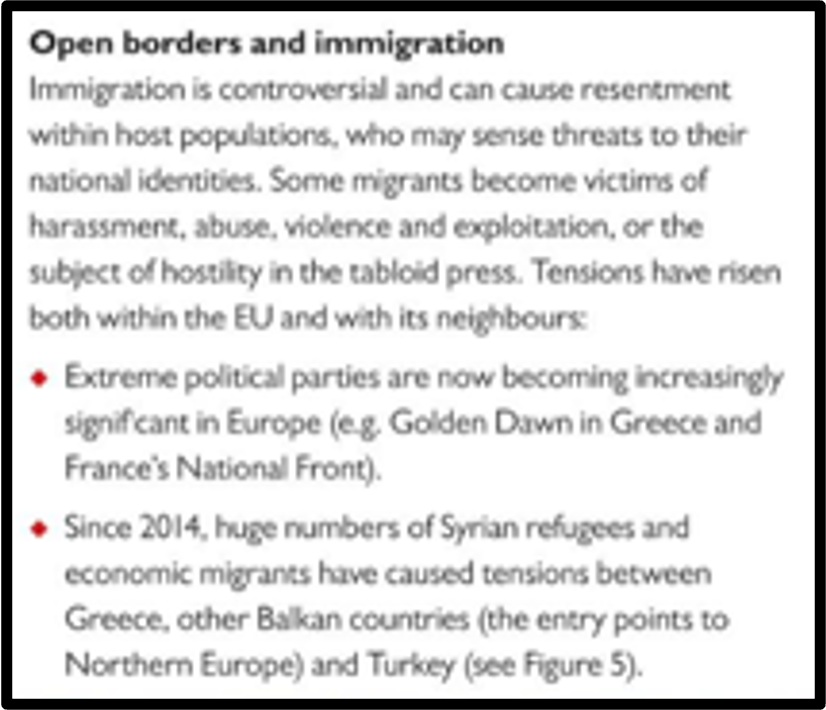
Core- periphery model
Greater source east as core- mainly the target for migration. Periphery is characterised by low household income, lower employment rates, low levels of inward investment (therefore would be expected that rates of migration to London will be significantly greater than from core to periphery).

Migration changes the cultural and ethnic composition of nation states but the integration of migrants varies both between nations and within them.
Define identity and Sovereignty
Identity: a sense of a nation as a cohesive whole, as represented by distinctive traditions, culture, and language.
Sovereignty: The ability of a place and its people to self govern without any outside interference
National Identity
British Identity- notes from a video
stiff upper lip
diversity, culture, fish and chips
progress
tradition
patriotic
collective identity of the UK
unity
freedom?
How much of this is true?
Misinformation on offshoring and outsourcing removing jobs from locals who believe that is the fault of migrants.
Donald Trumps- wall
social and national security

Does migration (free movement) pose challenges for national identity and sovereignty?
Push factors for internal migration from Coastal North to South in the UK
deindustrialisation
lack of jobs
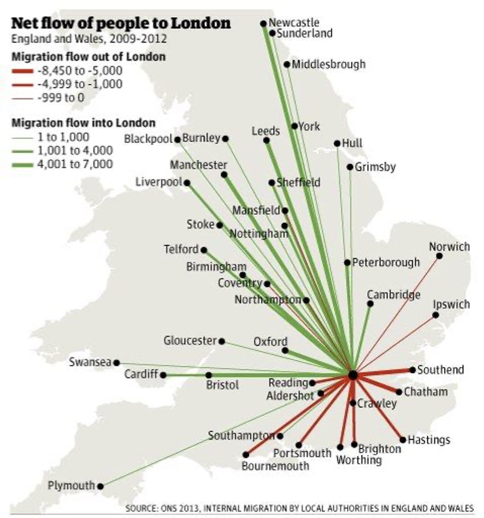
Pull factors for internal migration from London to south-east in the Uk
better job opps
tertiary, quaternary and quinary job market rather than agriculture or manufacturing
Is the North-south divide being challenged?
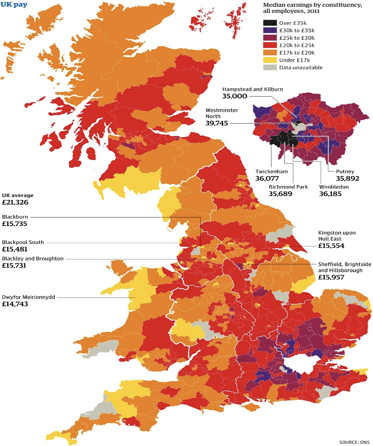
Migration causes political tensions because of differences in perceptions of the social, economic, cultural and demographic impacts ( Labour flows across the Mexico-US border and between EU states). (3)
There are variations in the ability of people to migrate across national borders according to levels of skill and income; and opportunities, including the presence or absence of controls and international borders.
National sovereign states vary greatly in their ethnic, cultural and linguistic unity ( Iceland compared to Singapore); this results from their history of population growth, their degree of isolation and the role of migration. (4)
Many national borders are a consequence of physical geography and historical development; other borders are a result of colonial history and might not take account of different ethnic or religious groups ( Iraq or Rwanda), which can lead to problems of sovereignty and legitimacy.
There are many contested borders ( Ukraine/Russia) and not all nation states are universally recognised as such ( Taiwan) which can lead to both potential conflict and population movements.
19th-century nationalism was important in the development of empires and a source of conflict in Europe and beyond as other nations became part of larger empires ( British Raj in India).
Since 1945, many new nation states have emerged as European empires disintegrated ( 1960s ‘wind of change’ in Africa); the transition to independence frequently involved conflicts that were costly environmentally, economically and in human terms ( Viet-Nam or Sudan).
Patterns of migration between former colonies and the imperial core country are still evident and important in changing the ethnic composition and cultural heterogeneity of those countries. (5)
Globalisation has encouraged the growth of states that have low-tax regimes which provide havens for the profits for TNCs and homes for wealthy expatriates
Most governments and IGOs have accepted the emergence of tax-havens although many NGOs have raised objections.
Growing global inequalities have been recognised as a major threat to the sustainability of the global economic system and some governments have promoted alternative models ( Bolivia or Ecuador). (6)
Leaders from several South American, African & Asian countries have repeatedly criticised the way some new and some old nations gain from trade disproportionately.
The United Nations was the first post-war IGO to be established and has grown in importance; its role in global governance is affected by the different geopolitical visons of members of the Security Council and its multiple functions in managing global environmental, socio-economic and political problems.
Interventions by the UN through the use of economic sanctions and direct military intervention have been made in defence of human rights but have a mixed record of success. ( Trade Embargo Iran or UN forces in Congo).
Some member states (US, UK) have operated independently of the UN in intervening in countries labelled as ‘fragile states’ or to conduct a ‘war on terror’ with profound impacts on geopolitical relations and global stability.
The IMF, WB and WTO were established by the WWII allied nations and have been important in maintaining the dominance of ‘western’ capitalism, global economic management and trade policy (free trade).
Global borrowing rules and trade policies have been especially effective in delivering growth to the developed world, but the impact of Structural Adjustment and HIPC policies on the developing world’s economies and economic sovereignty is disputed ( Jamaica’s structural adjustment programme).
Membership of global trade and financial IGOs is almost universal, as a result of the dominance of these organisations, but regional groupings have emerged in the form of trading blocs ( NAFTA/SEATO) and in some cases (EU) there has been a movement to closer political unity
Global environmental issues including issues concerning the quality of the atmosphere and biosphere ( Montreal Protocol on Substances that Deplete the Ozone Layer) and biosphere ( Convention on International Trade in Endangered Species of Wild Fauna and Flora CITES). (7)
IGOs have been involved in developing laws for managing oceans ( UN Convention on the Law of the Sea) and international rivers ( Helsinki Water Convention rules) as well as monitoring the state of the environment ( Millennium Ecosystem Assessment).
IGO management also includes responsibility for Antarctica as a continent of peace and science ( Antarctic Treaty System).
Nationalism remains a powerful force; it is reinforced through education, sport and by political parties stressing loyalty to both the institutions and the ideals of nation states.
Identity and loyalty has historically been tied to distinctive legal systems, methods of governance, national ‘character’ or even a landscape ( The English Countryside).
Most countries are multi-national with many contrasting ethnic groups; questions of national identity and loyalties are therefore complex, especially in an era of globalisation.
Many UK-based companies are foreign owned ( EDF or Jaguar Land Rover (JLR)), making ‘Made in Britain’ an increasingly complex idea. (8)
‘Westernisation’ is often dominated by US cultural values through the operation of large corporations in both retailing and entertainment; this, in turn, promotes a distinctive view of the benefits the dominant capitalist model.
Ownership of property, land and businesses in countries is increasingly non-national ( Qatari and Russian property in London and US or Indian or Chinese ownership of TNCs), which impacts on national identity. (9)
There are strong nationalist movements seeking to create independent, smaller states whilst remaining within larger trading groups ( Catalonia or Scotland in the EU).
Issues can arise when states exist across multiple borders
There are significant political tensions in the BRIC and other emerging nations resulting from the uneven pattern of the costs and benefits of globalisation.
The role of the state is variable and national identity is not always strong, especially in ‘fragile states’ where there are stark differences between the politically and economically powerful elite, foreign investment groups and the wider population ( Somalia). (10)